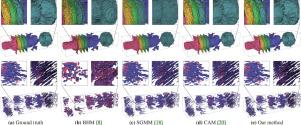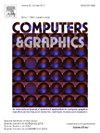面向大规模多变量SAMR数据分析与可视化的特征驱动紧凑表示模型
IF 2.8
4区 计算机科学
Q2 COMPUTER SCIENCE, SOFTWARE ENGINEERING
引用次数: 0
摘要
超级计算机的存储开销和I/O瓶颈给大规模多变量SAMR数据的有效分析和可视化带来了挑战。因此,有必要在保持数据准确性的前提下,大幅度减少数据的大小。在本文中,我们提出了一个特征驱动的紧凑表示模型来处理结构复杂、高维和非线性的结构化自适应网格细化(SAMR)数据,以实现高效的存储、分析和可视化。我们将信息引导的领域划分、基于距离的降维和错误边界的数据表示结合起来,形成了一个连贯的三组件框架,在保证低精度损失的同时实现了高压缩比。我们的方法解决了大规模并行科学模拟产生的大规模多元SAMR数据可视化的关键瓶颈,即压缩效率和数据保真度之间的相互约束关系。我们使用四个数据集验证了我们方法的有效性,其中最大的数据集包含40亿个网格点。实验结果表明,与最先进的方法相比,我们的方法将数据存储成本降低了大约一个数量级,同时将数据重建精度提高了近两个数量级。本文章由计算机程序翻译,如有差异,请以英文原文为准。

Feature-driven compact representation model for analysis and visualization of large-scale multivariate SAMR data
The storage overhead and I/O bottleneck of supercomputers creates a challenge in efficiently analyzing and visualizing large-scale multivariate SAMR data. It is thus necessary to greatly reduce the data size on the premise of maintaining data accuracy. In this paper, we propose a feature-driven compact representation model to handle structurally complex, high-dimensional, and nonlinear structured adaptive mesh refinement (SAMR) data for efficient storage, analysis, and visualization. We combine information-guided domain partition, distance-based dimensionality reduction, and error-bounded data representation to form a coherent three-component framework, achieving high compression ratios while ensuring low accuracy loss. Our approach addresses the key bottleneck in the visualization of large-scale multivariate SAMR data generated by massively parallel scientific simulations, namely the mutual restraint relationship between compression efficiency and data fidelity. We validate the effectiveness of our method using four datasets, the largest of which contains 4 billion grid points. Experimental results demonstrate that, compared with the state-of-the-art methods, our approach reduces data storage costs by approximately an order of magnitude while improving data reconstruction accuracy by nearly two orders of magnitude.
求助全文
通过发布文献求助,成功后即可免费获取论文全文。
去求助
来源期刊

Computers & Graphics-Uk
工程技术-计算机:软件工程
CiteScore
5.30
自引率
12.00%
发文量
173
审稿时长
38 days
期刊介绍:
Computers & Graphics is dedicated to disseminate information on research and applications of computer graphics (CG) techniques. The journal encourages articles on:
1. Research and applications of interactive computer graphics. We are particularly interested in novel interaction techniques and applications of CG to problem domains.
2. State-of-the-art papers on late-breaking, cutting-edge research on CG.
3. Information on innovative uses of graphics principles and technologies.
4. Tutorial papers on both teaching CG principles and innovative uses of CG in education.
 求助内容:
求助内容: 应助结果提醒方式:
应助结果提醒方式:


